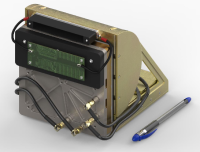Compact Ion Mass Spectrometer (CIMS)
| Compact Ion Mass Spectrometer (CIMS) | |
|---|---|
 | |
| Principal Investigator | Carlos Maldonado |
| Institution | Los Alamos National Laboratory (LANL) |
| Technology Readiness Level | 3 |
| Instrument Type | Ion Mass Spectrometer |
| Project Status | Active |
| Project ID | 20-HTIDS-20-0012 |
Overview
The Compact Ion Mass Spectrometer (CIMS) is a highly compact ion mass spectrometer capable of mass resolution for low-energy space plasma. CIMS is capable of measuring flux, energy, and mass of ions providing measurements of the ionospheric outflow and cold plasma in the magnetosphere. The CIMS utilizes a laminated collimator to define the field-of-view, a laminated electrostatic analyzer to selectively filter ions based on energy -per-charge, a magnetic sector analyzer to separate ions by mass-per-charge, and a microchannel plate with a position sensitive cross-delay anode assembly to detect the location of the ions on the detector plane. This ion mass spectrometer is a simple, compact, and robust instrument for obtaining low-energy (0.1 eV to 1000 eV) ion composition measurements (H+, He+ , He++, O+, N+, NO+, N2+) of ionospheric and cold magnetospheric space plasma.
Principle of Operations
The CIMS instrument is most accurately described as a double focusing mass spectrometer and utilizes electric and magnetic field geometries to focus in both direction and energy. With the use of this design, based on the Mattauch-Herzog geometry, multiple ion species are spatially distributed by M/q along the focal plane and can be observed simultaneously as a true mass spectrum. The instrument is comprised of:
- a collimator to set the field-of-view (FOV);
- a laminated electrostatic analyzer to selectively filter ions by E/q;
- a magnetic sector analyzer to separate ions by M/q; and
- a microchannel plate (MCP) followed by position sensitive cross delay anode (XDL) assembly to detect the location of the ions on the detector plane.
Advantages and Disadvantages
The instrument design has significant mass and volume savings when compared to current state-of-the-art ion mass spectrometers and has the additional advantage of being able to simultaneously measure multiple ion species signals of a given energy at 100% duty cycle, thus providing a true mass spectrum. The extremely low resource requirements of the CIMS instrument in combination with the relaxed fabrication techniques and ease of assembly allows for rapid and low-cost production.
Flight Heritage
None
Applications
Not yet planned.
Image Gallery
Funding
- Funded by HTIDS20, proposal number 20-HTIDS20-0012
Presentations, Publications, and Patents
Publications
- C. A. Maldonado, H. Morning, G. R. Wilson, J. McGlown, D. Arnold, D. Reisenfeld, and M. Holloway, An Ultra-Low Resource Ion Mass Spectrometer for CubeSat Platforms, 2022 SmallSat Conference, Logan UT, 2022.
Presentations
- Maldonado, C. A., G. R Wilson, D. B. Reisenfeld, T. K. Kim, J. McGlown, M. Holloway, H. Morning, and D. W. Arnold, An Ultra-Low Resource Ion Mass Spectrometer for Observations of Planetary Ionospheres, AGU Fall Meeting, Chicago, 2022. (LA-UR-22-32819)
Patents
- C. A. Maldonado and D. B. Reisenfeld, Compact and Ruggedized Collimated Laminated Electrostatic Analyzer for Investigating Space Plasmas - U.S. Provisional Application Number 63/396,173
- C. A. Maldonado, G. R. Wilson, D. B. Reisenfeld, J.McGlown, M. Holloway, H.Morning, and D. W. Arnold, An Ultra-Compact I on Mass Spectrometer for Space and Laboratory Plasma Measurements (submitted to LANL Feynman Center for Innovation - S167645)
